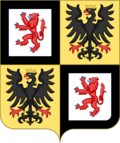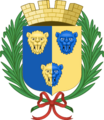Coat of arms of Durland
| Coat of arms of Durland | |
|---|---|
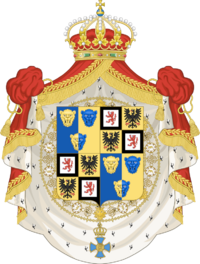 Greater (royal) version | |
| Versions | |
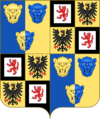 Middle version | |
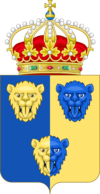 Lesser (state) version | |
| Armiger | Carilla, Princess of Durland |
| Adopted | Initially adopted on 14 August 1876. Modified 1877. Readopted 9 April 1928. |
| Torse | tasseled strings Or |
| Blazon | Quarterly, I and IV Per pale Azure and Or btween three leopard heads caboshed all countercharged. II and III Argent a lion rampant Gules within a bordure Sable impaling Or, an eagle displayed sable beaked and membered Gules and Crowned Or. |
| Orders | Order of Prince Jora |
| Other elements | The monarch places this coat of arms on a mantle gules lined with Ermine. Above the mantle is a pavilion gules again topped with the royal crown. |
The coat of arms of Durland is the arms of dominion of Princess Carilla of Durland, and is used to represent both the monarch and the state. The shield quarters the attributed arms of Prince Jora and the House of Leps, representing the state and the ruling house respectively.
The coat of arms is used to represent the authority of the state; the monarch, government, and Supreme Court all use versions of the arms to assert their legitimate authority. The government uses a variation of the arms without mantle or order, which is known as the state arms. Members of the Princely Family maintain their own arms for use in a private capacity.
History
Prior to Garindinian colonisation, Durland was a collection of petty principalities united under the common rule of a Grand Prince. There were various armorials used by and attributed to these rulers. Prince Jora, who reigned as Grand Prince between 1527 and 1574, adopted a vertically-divided shield of blue and gold countercharged with three leopards heads. Jora's successors (including both legitimate descendants and unrelated rulers) continued to use these arms until Durland's eventual colonisation.
On Durland's independence, the government resurrected the arms of Prince Jora, claiming direct continuity with the pre-colonial Durlish principalities. With the election of Farnar II as prince, these arms were quartered with those of the House of Leps, the new ruling dynasty, although the latter design being revised. The eventual design, including crown and mantle, were designed by Farnar himself; an amateur herald and artist, he reportedly designed the arms on the back of an envelope whilst en route to Herran. Although in use from 1875, the arms were not officially registered until 1876. On the creation of the Order of Prince Jura the following year, the arms were amended to include the order as a circlet around the escutcheon.
| The Arms of Prince Jora | The Arms of the House of Leps |
In 1922, following the abolition of the monarchy and the establishment of the Second Durlish Republic, the coat of arms was redesigned to remove all references to the monarchy. The armorial of the House of Leps was removed, as was the crown and order. The mantle was replaced with a wreath, with the princely crown replaced by a mural one. Proposals for a wholly new emblem severing all connection with the previous regime were initially made, but never carried through.
On the restoration of the monarchy in 1928, the princely arms readopted. In 1967, new regulations established a new state coat of arms consisting solely of the arms of Prince Jora, redesignating the quartered arms as the arms of the princely house. Nonetheless, the greater arms continues to be the arms of the state as a symbol of the Crown's role as embodiment of the state.
Design
The arms, whilst initially designed by Farnar II, was formally designed by the painter Halnar Freesdat, who the prince personally selected for the task. The design he presented was closely aligned with Farnar's original vision, and was approved with little debate.
Two main versions of the coat of arms have been established for use. Their use is regulated by law, and both feature the arms of Prince Jora.
The main version is known as the "Princely Arms" and are those of the monarch. This version consists of the shield quartered, bearing both the arms of Prince Jora and the arms of the House of Leps. This version is intended for use by the monarch and members of the princely family, with the latter using the arms differenced. These arms are generally seen as part of an heraldic achievement, along with mantle, crown, and order. Although the Armorial Act 1967 designated these arms as dynastic rather than national, they nonetheless continue to be arms of dominion.
The second version consists of only the arms of Prince Jora, usually with a princely crown. These arms are used by the government and represent the state's authority. The crown is the sole monarchical element, with the achievement featuring no mantling or order. Occasionally, this version is unofficially referred to as the "lesser arms" or the "government arms". It appears on government documents (including passports) and in the logos of government ministries.
As per the registration with the Court of Arms, the full achievement is blazoned: Quarterly, I and IV Per pale Azure and Or between three leopard heads caboshed all countercharged. II and III Argent a lion rampant Gules within a bordure Sable impaling Or, an eagle displayed sable beaked and membered Gules and Crowned Or. The shield is surrounded by the insignia of the Order of Prince Jura, and all surrounded by mantling Gules doubled ermine, crowned with the royal crown and tied up with tassled strings Or.
Charges
Arms of Prince Jora
Three leopard faces have long been associated with Durlish heraldry, and variations of the design have been observed stretching back to the fifteenth century. Prince Jora adopted as his arms three leopard faces countercharged on a vertically-divided shield of blue and gold. The colour blue is a Durlish national colour and has featured in Durlish flags and banners for over a millennium, whilst gold had appeared in various arms within the Maagbilra dynasty.
The origin of the panthers is probably linked to the mythical lanlan, a cat-like creature in Durlish folktale. The taming of the lanlan marked the assumption of supreme political power, with the design representing Jora's rule over the three senior petty Durlish principalities.
Arms of the House of Leps
The arms of the House of Leps consists of the arms of the Princes of Leps impaled with those of the Counts Yudin. The Leppian arms (colloquially known as the "Leppian lion" consists of a red lion rampant on a white shield differenced with a black border. In medieval Garindinian heraldry, borders were used to denote children of the armorial bearer, with black usually assigned to the third-born son. Little is known about the origins of the arms, although various ideas have been proposed.
With the marriage of Selena, Countess Yudin to Prince Demian Leps, her arms were impaled with those of the Leps family, of which he was head. The Yudin arms consists of a black eagle on a golden field. Although Farnar II, born Prince Tomas Leps, bore the two arms quartered as the head of both houses, he directed the arms of the Lepps and Yudin families to be impaled for inclusion in the new Durlish armorial, representing the union of the two houses and simplifying the overall design.
Variants
Princely family
Members of the Princely Family are granted their own personal arms. The arms of the monarch are those of the state (arms of dominion). Children of the monarch are able to bear their own arms, which are usually granted on their twenty first birthday unless eligibility precedes this age, which consist of the monarch's arms differenced with a white label. Other members of the princely family may be granted arms at the direction of the monarch. In accordance with rules established by Farnar II, the arms of the monarch's children are differenced with a three-point label, whilst those of grandchildren are differenced with a five-point label. The labels are always white and include individual marks to form the particular difference.
Princess consorts and the wives of the monarch's sons also have their own personal arms, which consists of the arms of their husbands impaled with either their own or their father's arms.
Currently the following members of the princely family have their own arms based on the royal arms:

